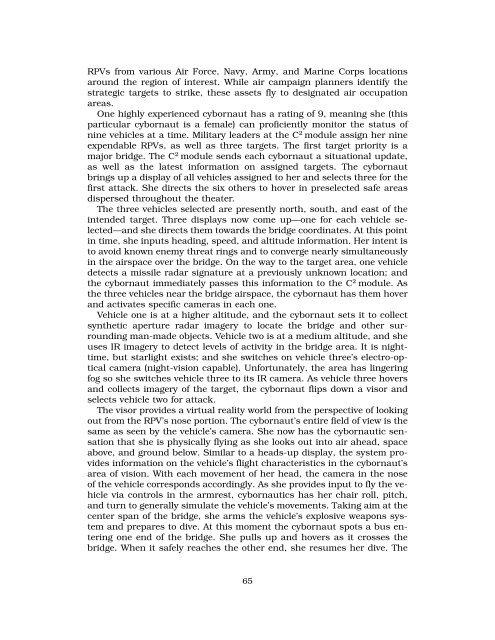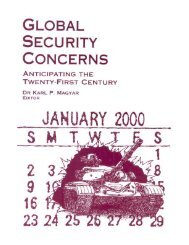Expendable Remotely Piloted Vehicles for Strategic Offensive ...
Expendable Remotely Piloted Vehicles for Strategic Offensive ...
Expendable Remotely Piloted Vehicles for Strategic Offensive ...
Create successful ePaper yourself
Turn your PDF publications into a flip-book with our unique Google optimized e-Paper software.
RPVs from various Air Force, Navy, Army, and Marine Corps locationsaround the region of interest. While air campaign planners identify thestrategic targets to strike, these assets fly to designated air occupationareas.One highly experienced cybornaut has a rating of 9, meaning she (thisparticular cybornaut is a female) can proficiently monitor the status ofnine vehicles at a time. Military leaders at the C 2 module assign her nineexpendable RPVs, as well as three targets. The first target priority is amajor bridge. The C 2 module sends each cybornaut a situational update,as well as the latest in<strong>for</strong>mation on assigned targets. The cybornautbrings up a display of all vehicles assigned to her and selects three <strong>for</strong> thefirst attack. She directs the six others to hover in preselected safe areasdispersed throughout the theater.The three vehicles selected are presently north, south, and east of theintended target. Three displays now come up—one <strong>for</strong> each vehicle selected—andshe directs them towards the bridge coordinates. At this pointin time, she inputs heading, speed, and altitude in<strong>for</strong>mation. Her intent isto avoid known enemy threat rings and to converge nearly simultaneouslyin the airspace over the bridge. On the way to the target area, one vehicledetects a missile radar signature at a previously unknown location; andthe cybornaut immediately passes this in<strong>for</strong>mation to the C 2 module. Asthe three vehicles near the bridge airspace, the cybornaut has them hoverand activates specific cameras in each one.Vehicle one is at a higher altitude, and the cybornaut sets it to collectsynthetic aperture radar imagery to locate the bridge and other surroundingman-made objects. Vehicle two is at a medium altitude, and sheuses IR imagery to detect levels of activity in the bridge area. It is nighttime,but starlight exists; and she switches on vehicle three’s electro-opticalcamera (night-vision capable). Un<strong>for</strong>tunately, the area has lingeringfog so she switches vehicle three to its IR camera. As vehicle three hoversand collects imagery of the target, the cybornaut flips down a visor andselects vehicle two <strong>for</strong> attack.The visor provides a virtual reality world from the perspective of lookingout from the RPV’s nose portion. The cybornaut’s entire field of view is thesame as seen by the vehicle’s camera. She now has the cybornautic sensationthat she is physically flying as she looks out into air ahead, spaceabove, and ground below. Similar to a heads-up display, the system providesin<strong>for</strong>mation on the vehicle’s flight characteristics in the cybornaut’sarea of vision. With each movement of her head, the camera in the noseof the vehicle corresponds accordingly. As she provides input to fly the vehiclevia controls in the armrest, cybornautics has her chair roll, pitch,and turn to generally simulate the vehicle’s movements. Taking aim at thecenter span of the bridge, she arms the vehicle’s explosive weapons systemand prepares to dive. At this moment the cybornaut spots a bus enteringone end of the bridge. She pulls up and hovers as it crosses thebridge. When it safely reaches the other end, she resumes her dive. The65






